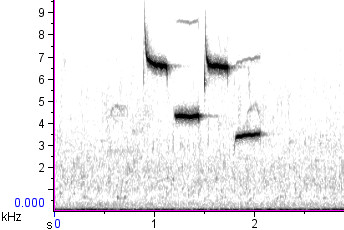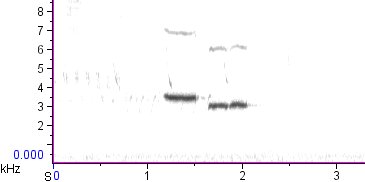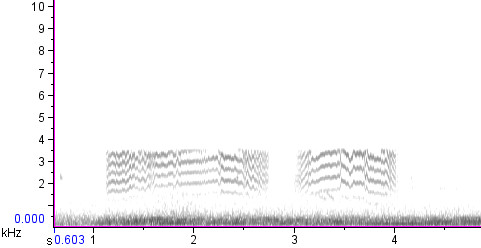Hearing Loss and Bird Sounds

In honor of Earbirding’s first birthday (yes, we went live one year ago today), I’m posting on the topic of getting older — and losing your hearing as you age.
Age-related hearing loss, or presbycusis, happens to almost everyone to some degree, although it tends to be more severe among men, and susceptibility can run in families. It runs in my family, for better or for worse — even though I’m not yet 35, when I go birding with my friend Walter, he can detect chickadees by ear at twice the distance at which I can hear them. The other day, he and I watched a Blue-gray Gnatcatcher vocalizing at a distance of about 50 meters. He could hear it distinctly; I watched the bird’s bill opening and closing in silence.
Age-related hearing loss tends to affect high frequencies first, so that the upper frequency limit of a person’s hearing tends to decrease over time. A European inventor exploited this fact to create a device called “the Mosquito,” a type of sonic “youth repellent” that keeps bus stations and storefronts free of loitering juvenile delinquents by emitting a piercing high-pitched frequency that only young people can hear. (In retaliation, young people have converted the “Mosquito’s” buzz into a cell phone ringtone that their aging teachers can’t hear when it rings in class.)
In the past I’ve written about some corrective technologies for birding by ear. Today I’d like to give those of you with perfect ears a chance to experience partial hearing loss. It’s easy to filter out the high frequencies of bird sounds to get an idea of what you would hear if they were missing. Some songs, like those of the Golden-crowned Kinglet, would disappear entirely. Click on the link to test your hearing — if you can still hear the kinglet’s song, then your ears are pretty good. I can still hear high-pitched songs like this just fine, as long as they are at close range.
But there are other ways that hearing loss can affect our perception of sounds besides eliminating the songs entirely.
Losing Songs in Pieces
Some bird sounds are composed of both high- and low-pitched notes, so that those with presbycusis may hear parts of the sound and not others. A great example is the typical “fee-bee, fee-bay” song of the Carolina Chickadee, which is one of the best ways to distinguish it from the lookalike Black-capped Chickadee, which sings a simple “fee bee.” The complete song is easy to identify:

But those with an upper hearing threshold of 6 kHz, which constitutes only a moderate hearing loss, will hear just the two lower notes:

And that makes it sound much more like the Black-capped Chickadee:

Hearing Loss and Tone Quality
I used to be skeptical that presbycusis could affect the tone quality of sounds, but in some cases it can, especially if the sound is highly nasal.
Here’s a quick reminder in case it’s been a while since you visited the page that explains the nasality of sounds. To have a nasal tone quality, a sound must be harmonically complex. Such sounds appear on the spectrogram as vertical stacks of lines. If the darkest lines in the stack are at the bottom, the quality of the sound won’t be nasal at all. The higher the darkness climbs, the more nasal the sound. Thus, the call of the California Gnatcatcher sounds intensely nasal:

Here’s the same sound, filtered above 6 kHz. Note that the basic sound remains the same, but the quality changes slightly. However, I’d still call it “nasal.”

Here’s the sound filtered about 3.5 kHz. (This is about the same level of high-frequency filtering forced on all of us by our telephones. If you’ve ever wondered why people’s voices sound slightly different over the phone, it’s because the phone companies decided long ago that those higher pitches were mostly unnecessary to human speech, so they simply aren’t transmitted.) This version of the call maintains its basic pitch (because pitch is determined by the spacing between the partials), but the quality is muted, duller, and less nasal.
